|

from
Violations Website
Book IV
Secrets of The Third Reich
Part I
Secrets of the Third Reich
Part I
The fact that the Germans were developing advanced technologies
during the end of the war is a matter of public record. As
 Sir Roy Feddon, Chief of the Technical Mission to Germany for the Ministry
of Aircraft Production stated in 1945. Sir Roy Feddon, Chief of the Technical Mission to Germany for the Ministry
of Aircraft Production stated in 1945.
"…I have seen enough of their
designs and production plans to realize that if they (the Germans)
had managed to prolong the war some months longer, we would have
been confronted with a set of entirely new and deadly developments
in air warfare."
Captain Ruppelt, Chief of the US Air Force
Project Bluebook added in
1956,
"When WWII ended, the Germans had several radical types of
aircraft and guided missiles under development. The majority were in
the most preliminary stages, but they were the only known craft that
could even approach the performance of objects reported to UFO
observers…"
Some of these German war-time technical advances were well known.
The first military jet was the German Heinkel 178 that flew in 1939.
In 1943 the Germans also deployed the only jet fighter to go into
regular service during the war, the Messerschmitt 262. This jet
could easily overtake the fastest Allied aircraft, yet fortunately
Hitler ordered that these planes
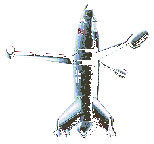 should be fitted as bombers rather
than defensive fighters which saved Allied aircraft from devastating
casualties. should be fitted as bombers rather
than defensive fighters which saved Allied aircraft from devastating
casualties.
Then Heinrich Focke was involved in the design of and production of
the FW6, Fa223, Fa226, Fa283 and 284 models during the war. He
designed a propulsion system known as the ‘turbo-shaft’, which is
still used in most helicopters today. Using this technology, Focke
designed this upright, vertical take-off aircraft, which was just
coming off the drawing board as the war ended. At the end of each of
the three long arms of this technologically advanced craft was a
small jet propulsion unit. The rotating arms were used to lift the
body from the ground like the blades of a helicopter.
In 1939 Focke patented a saucer-shaped craft with enclosed twin
rotors described as follows:
"The exhaust nozzle forked in two at
the end of the engine and ended in two auxiliary combustion chambers
located on the trailing edge of the wing. When fuel was added these
combustion chambers would act as afterburners to provide horizontal
propulsion to Focke’s design. The control at low speed was achieved
by alternatively varying the power from each auxiliary combustion
chamber."
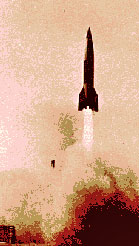 Cruise missiles were also first used by the Third Reich and
V-1
bombs were launched from German occupied territories across the
channel into England. Cruise missiles were also first used by the Third Reich and
V-1
bombs were launched from German occupied territories across the
channel into England.
The next German rocket, the V-2 proved to be the predecessor of the
Intercontinental Ballistic Missiles that filled the arsenals of the
former Soviet Union and US during the Cold War. This missile could
travel 225 miles at five times the speed of sound and a single hit
could take out a city block. The Germans also developed a
rocket-powered fighter, the ME 163 and although it was never put
into regular service, it was the first aircraft to fly faster than
600 miles per hour.
These then, were some of the known German advances. However there
were also hints of darker technologies not fully understood. It was
in 1944 that knowledge of these became public for the first time
when the New York Times of 14th December reported "Floating Mystery
ball is New German Weapon.
"Supreme Headquarters, Allied Expeditionary Force, Dec 13 - A new
German weapon has made its appearance on the western air front, it
was disclosed today. Airmen of the American Air Force report that
they are encountering silver coloured spheres in the air over German
territory. The spheres are encountered either singly or in clusters.
Sometimes they are semi-translucent.(1)
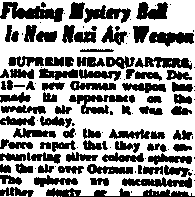 A typical incident was reported by a veteran pilot of the 415th
Night Fighter Squadron. He was flying a mission over Hagenau,
Germany on 22nd December 1944 when at 6.00am, whilst flying at an
altitude of ten thousand feet, the pilot and his radar operator saw
two "large orange glows" rapidly climbing towards them. A typical incident was reported by a veteran pilot of the 415th
Night Fighter Squadron. He was flying a mission over Hagenau,
Germany on 22nd December 1944 when at 6.00am, whilst flying at an
altitude of ten thousand feet, the pilot and his radar operator saw
two "large orange glows" rapidly climbing towards them.
"‘Upon
reaching our altitude’ the pilot reported, the objects ‘levelled off
and stayed on my tail.’ He went into a steep dive and the ‘glows’
followed in sharp precision. He banked as sharply as he dared and
the objects followed. For two minutes the ‘lights’ stalked the
fighter through several intricate manoeuvres, peeled off under
perfect control, then blinked out…"
(2)
The purpose of these strange objects was a mystery, for they merely
followed warplanes, but apparently never opened fire or otherwise
attacked them. These objects
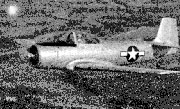 were named ‘Foo Fighters’, a term which
came from a headline ‘Where There’s Feu, There’s Fire.’ Each side in
the war seemed to believe that the Foo Fighters were the inventions
of their enemy and several reconnaissance missions were launched to
gain further information. To date, it has never been clearly
established where the technology came from, and the origins of the foo-fighters remain an historical puzzle alongside the Scandinavian
ghost rockets. What was clear, however, was that it wasn’t Allied
technology, and that was a serious cause of concern. were named ‘Foo Fighters’, a term which
came from a headline ‘Where There’s Feu, There’s Fire.’ Each side in
the war seemed to believe that the Foo Fighters were the inventions
of their enemy and several reconnaissance missions were launched to
gain further information. To date, it has never been clearly
established where the technology came from, and the origins of the foo-fighters remain an historical puzzle alongside the Scandinavian
ghost rockets. What was clear, however, was that it wasn’t Allied
technology, and that was a serious cause of concern.
Over the years fact and fiction regarding the exact nature of these
advanced German technologies have become fused, however it is now
clear that the Germans were developing craft that could be mistaken
for what would nowadays be considered UFOs. In fact, such
developments make perfect sense:
Each side during the war relied heavily on their aerial
capabilities, and one sure way to disable such abilities was to take
out enemy runways. Either side could have had the best air fleet on
the planet, but without somewhere to take off from, such a fleet was
impotent. Therefore the development of craft that did not require
any runway, like Focke’s designs, could potentially alter the
eventual course of the war. As it turned out, the designs were only
coming on line as the war ended, but had the conflict continued, it
is conceivable that these new technologies could have altered the
shape of history.
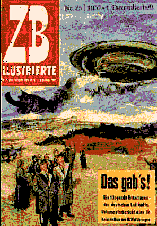 However, exactly what was being developed is now less a matter of
historical record, and more of an historical jigsaw, with not only
pieces missing, but other pieces conceived in the minds of writers
who then peddled fictitious Nazi flying saucer myths to those who
chose to believe them. However, exactly what was being developed is now less a matter of
historical record, and more of an historical jigsaw, with not only
pieces missing, but other pieces conceived in the minds of writers
who then peddled fictitious Nazi flying saucer myths to those who
chose to believe them.
Establishing fact from fiction from over fifty years ago is no easy
matter, and we are forced to consider information that is largely
unverifiable. Yet when pieced together a plausible story of Nazi
flying disk technology does begin to emerge.
One person who made claims regarding the development of ‘flying
saucers’ in Nazi Germany is former Luftwaffe Flight Captain and
aircraft designer Rudolph Schriever.
He claimed in 1950 that he and
a small team had worked at facilities near Prague developing a
saucer-type vehicle.
This story first appeared in ‘Der Spiegel’ magazine on 30th March
1950 in an article entitled ‘Untertassen-Flieger Kombination’ which
stated,
"… Rudolph Schriever, who says engineers throughout the world
experimented in the early 1940s with flying saucers, is willing to
build one for the United States in six to nine months.
The
40-year-old Prague University graduate said he made blueprints for
such a machine, which he calls a flying top, before Germany’s
collapse and that the blueprints were stolen from his laboratory.
He
says the machine would be capable of 2,600mph with a radius of 4,000
miles, Schriever is a US Army driver at Bremerhaven."
(3)
His claims are backed up by a 1975 Luftfahrt International Report
that noted that after Shriever’s death in the late 1950s, papers
found amongst his belongings revealed incomplete notes for a large
flying saucer, a series of sketches of the machine and several
newspaper clippings of himself and his alleged flying saucer.
Up to
his death, Schriever had repeatedly claimed that the UFO sightings
since the end of the war were proof that his original ideas had been
taken further with successful results.
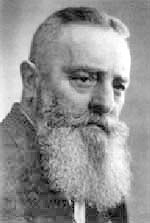 Researcher
Bill Rose was able to discover that Schriever was
involved with other scientists Klaus Habermohl and Giuseppe Belluzzo
(an Italian engineer) as well as one Dr. Walter Miethe. Rose’s
research established that Miethe had been the Director of the saucer
programme at two facilities located outside Prague. We know little
more about Miethe’s activities at this time him but it does seem
that he knew Wernher von Braun (of whom much more later) as there is
a photograph of them together in 1933. Researcher
Bill Rose was able to discover that Schriever was
involved with other scientists Klaus Habermohl and Giuseppe Belluzzo
(an Italian engineer) as well as one Dr. Walter Miethe. Rose’s
research established that Miethe had been the Director of the saucer
programme at two facilities located outside Prague. We know little
more about Miethe’s activities at this time him but it does seem
that he knew Wernher von Braun (of whom much more later) as there is
a photograph of them together in 1933.
We certainly do know that one scientist, Viktor Schauberger
(image right), was
involved in the production of flying disks, and that he flew one in
1945 near Prague, just as Schriever had claimed. His experimental
prototypes were based on levitation. Born in 1885, Schauberger
considered the natural world his greatest teacher although many in
the world considered Schauberger to be somewhat deranged. In
forests, alongside rivers, he studied what he considered
life-enhancing energy, water and air vortices.
He argued that,
"Prevailing technology uses the wrong forms of
motion. It is based on entropy – on motions which nature uses to
break down and scatter materials. However, nature uses a different
type of motion for creating order and new growth. The prevailing
explosion-based technology – fuel burning and atom splitting – fills
the world with expanding, heat-generating centrifugal motion."
Schauberger believed that energy production could instead use
inward-moving cold-generating centripetal motion, the same as nature
employs to build and enliven substances. Even hydroelectric power
plants, Schauberger said, use a destructive motion – they pressure
water and chop it through turbines. The result is ‘dead water’. He
built suction turbines that he considered enlivened and invigorated,
resulting in clean, life-giving water downstream.

Schauberger also produced electrical power from a unique suction
turbine using implosion principles and was later pressured into
developing a propulsion system using the same principles applied to
air.
His work came to Hitler’s attention and his son (left) recounts the
meeting between his father and Hitler:
"In June of 1934 my father
was invited by the Reich’s Chancellor Adolph Hitler to discuss his
work. Hitler wanted to know about his discoveries and talk about the
various possibilities and what his great plan was. And he said ‘yes,
I’m looking for a new technology that must once again harmonize with
the natural order of things and that is my real programme.’
"Shortly before the meeting, Hitler as Reich Chancellor gave the two
deputies his orders. The two had come to discuss Herman Goering’s
plan. And he said ‘Viktor Schauberger, you will speak with the two
Reich’s deputies and tomorrow or by the latest the day after
tomorrow a second meeting will take place. And he said to the two
deputies ‘I find the plan fascinating. Yes, we Germans will bring
about a whole new science.’" (4)
Hitler wanted Schauberger to supervise the building of a new flying
craft that could levitate without burning any fuel.
This idea
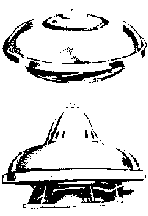 for
this new craft was based upon a discovery made by Schauberger a few
years before of how to develop a low-pressure zone at the atomic
level. The scientist claimed to have achieved this in a laboratory
setting when his prototype whirled air or water ‘radically and
axially’ at a falling temperature. Schauberger named this resulting
force as ‘diamagnetic levitation power’ and noted that nature
already used this direct or ‘reactionary’ suction force in weather
generation, solar fusion stability etc. for
this new craft was based upon a discovery made by Schauberger a few
years before of how to develop a low-pressure zone at the atomic
level. The scientist claimed to have achieved this in a laboratory
setting when his prototype whirled air or water ‘radically and
axially’ at a falling temperature. Schauberger named this resulting
force as ‘diamagnetic levitation power’ and noted that nature
already used this direct or ‘reactionary’ suction force in weather
generation, solar fusion stability etc.
Schauberger was given a team of scientists to help him with his
work, and he insisted that these be treated as free men rather than
prisoners of the Nazis. During their work, however, their research
headquarters was bombed and they were all transferred to Leonstein.
There they perfected the ‘flying disc’ powered by Schauberger’s
turbine which rotated air into a twisting type of oscillation
resulting in the build-up of immense power causing levitation.
Schauberger’s prototype was then developed into a vehicle known as
the Belluzzo-Schriever-Miethe Diskus, a machine built up to 22ft in
diameter. These craft travelled at over 2000 km/hr and were planned
to go over 4,000 km/hr. By 1945 they could reach 1300 mph and gain
an altitude of 40,000 feet in less than three minutes. The craft was
also noted to glow blue-green as it rose and left a silvery glow.
The Munich publication, ‘Da Neue Zeitalter’ wrote in 1956,
"Viktor Schauberger was the inventor and discoverer of the new motive power,
implosion, which, with the use of only air and water, generated
light, heat and motion."
The publication reported that the first unmanned flying disc, what
to an observer would have appeared to be Nazi UFOs, was tested in
1945 near Prague, that it could hover motionless in the air and
could fly as fast backwards as forwards. It was also
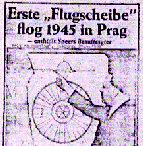 reported to
have a diameter of 50 meters. reported to
have a diameter of 50 meters.
Other evidence in support of this event had appeared earlier in an
interview given on 18th November 1954 to the Zurich-based ‘Tages Anzeiger’. One
George Klein stated that he had witnessed Nazi UFOs
flying saucer test on 14th February 1945 and that the craft had
reached a height of 30,000 foot in three minutes and could travel at
hundreds of miles an hour.
In this interview, Klein gave further information regarding
developments behind the disks, claiming that some of the work had
taken place at Peenemunde, where the V-2 rocket was being developed
and where Wernher von Braun was director. Klein also stated that the
stability of the craft had been achieved by using a gyroscope; the
same method used by the Von Braun-Dornberger team. The research then
moved to the Mittlewerke underground facilities near Nordhausen in
the Harz Mountains.
The ‘Bible’ of the story of the development of the Atomic bomb,
‘Brighter than a Thousand Suns’, also confirms these events:
"The
first of these flying saucers, as they were later called – circular
in shape, with a diameter of some 45 yards – were built by the
specialists Schriever, Habermohl and Miethe. They were first
airborne on February 14th 1945, over Prague and reached in three
minutes a height of nearly eight miles. They had a speed of 1.250 mph
which was doubled in subsequent tests."
(5)
That these events occurred is also supported by former
CIA agent
Virgil Armstrong who commented:
"We know that in the early parts of
the war there were certain factions of the Allied forces that did
not believe he had a secret weapon and it wasn’t until the Americans
made much emphasis of this that they began to look at it seriously
and indeed did discover that Hitler not only had a secret weapon, he
had what we would call today a UFO or spacecraft.
References:
(1) New York Times 14th December 1944.
(2) Lore, Gordon I. R. Jnr., and Deneault, Harold H., Jnr.,
‘Mysteries of the Skies; UFOs in Perspective’ p. 116 Prentice-Hall,
New Jersey 1968.
(3) ‘Der Spiegel’ magazine 30th March 1950
(4) Third Reich Video
(5) Jungk, Robert, ‘Brighter Than a Thousand Suns’ p. 87
|

 Sir Roy Feddon, Chief of the Technical Mission to Germany for the Ministry
of Aircraft Production stated in 1945.
Sir Roy Feddon, Chief of the Technical Mission to Germany for the Ministry
of Aircraft Production stated in 1945.  should be fitted as bombers rather
than defensive fighters which saved Allied aircraft from devastating
casualties.
should be fitted as bombers rather
than defensive fighters which saved Allied aircraft from devastating
casualties. Cruise missiles were also first used by the Third Reich and
V-1
bombs were launched from German occupied territories across the
channel into England.
Cruise missiles were also first used by the Third Reich and
V-1
bombs were launched from German occupied territories across the
channel into England.  A typical incident was reported by a veteran pilot of the 415th
Night Fighter Squadron. He was flying a mission over Hagenau,
Germany on 22nd December 1944 when at 6.00am, whilst flying at an
altitude of ten thousand feet, the pilot and his radar operator saw
two "large orange glows" rapidly climbing towards them.
A typical incident was reported by a veteran pilot of the 415th
Night Fighter Squadron. He was flying a mission over Hagenau,
Germany on 22nd December 1944 when at 6.00am, whilst flying at an
altitude of ten thousand feet, the pilot and his radar operator saw
two "large orange glows" rapidly climbing towards them.  were named ‘Foo Fighters’, a term which
came from a headline ‘Where There’s Feu, There’s Fire.’ Each side in
the war seemed to believe that the Foo Fighters were the inventions
of their enemy and several reconnaissance missions were launched to
gain further information. To date, it has never been clearly
established where the technology came from, and the origins of the foo-fighters remain an historical puzzle alongside the Scandinavian
ghost rockets. What was clear, however, was that it wasn’t Allied
technology, and that was a serious cause of concern.
were named ‘Foo Fighters’, a term which
came from a headline ‘Where There’s Feu, There’s Fire.’ Each side in
the war seemed to believe that the Foo Fighters were the inventions
of their enemy and several reconnaissance missions were launched to
gain further information. To date, it has never been clearly
established where the technology came from, and the origins of the foo-fighters remain an historical puzzle alongside the Scandinavian
ghost rockets. What was clear, however, was that it wasn’t Allied
technology, and that was a serious cause of concern. However, exactly what was being developed is now less a matter of
historical record, and more of an historical jigsaw, with not only
pieces missing, but other pieces conceived in the minds of writers
who then peddled fictitious Nazi flying saucer myths to those who
chose to believe them.
However, exactly what was being developed is now less a matter of
historical record, and more of an historical jigsaw, with not only
pieces missing, but other pieces conceived in the minds of writers
who then peddled fictitious Nazi flying saucer myths to those who
chose to believe them.  Researcher
Bill Rose was able to discover that Schriever was
involved with other scientists Klaus Habermohl and Giuseppe Belluzzo
(an Italian engineer) as well as one Dr. Walter Miethe. Rose’s
research established that Miethe had been the Director of the saucer
programme at two facilities located outside Prague. We know little
more about Miethe’s activities at this time him but it does seem
that he knew Wernher von Braun (of whom much more later) as there is
a photograph of them together in 1933.
Researcher
Bill Rose was able to discover that Schriever was
involved with other scientists Klaus Habermohl and Giuseppe Belluzzo
(an Italian engineer) as well as one Dr. Walter Miethe. Rose’s
research established that Miethe had been the Director of the saucer
programme at two facilities located outside Prague. We know little
more about Miethe’s activities at this time him but it does seem
that he knew Wernher von Braun (of whom much more later) as there is
a photograph of them together in 1933.
 for
this new craft was based upon a discovery made by Schauberger a few
years before of how to develop a low-pressure zone at the atomic
level. The scientist claimed to have achieved this in a laboratory
setting when his prototype whirled air or water ‘radically and
axially’ at a falling temperature. Schauberger named this resulting
force as ‘diamagnetic levitation power’ and noted that nature
already used this direct or ‘reactionary’ suction force in weather
generation, solar fusion stability etc.
for
this new craft was based upon a discovery made by Schauberger a few
years before of how to develop a low-pressure zone at the atomic
level. The scientist claimed to have achieved this in a laboratory
setting when his prototype whirled air or water ‘radically and
axially’ at a falling temperature. Schauberger named this resulting
force as ‘diamagnetic levitation power’ and noted that nature
already used this direct or ‘reactionary’ suction force in weather
generation, solar fusion stability etc. reported to
have a diameter of 50 meters.
reported to
have a diameter of 50 meters.